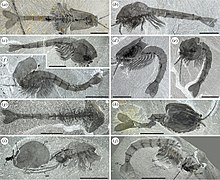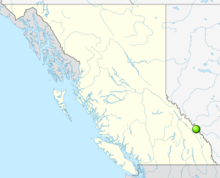| Waptia Temporal range:
| |
|---|---|

| |
| Fossil specimens of Waptia | |

| |
| Artist's reconstruction of Waptia fieldensis | |
| Scientific classification | |
| Domain: | Eukaryota |
| Kingdom: | Animalia |
| Phylum: | Arthropoda |
| Clade: | Mandibulata |
| Order: | †Hymenocarina |
| Genus: | †Waptia Walcott, 1912 |
| Species: | †W. fieldensis
|
| Binomial name | |
| †Waptia fieldensis Walcott, 1912
| |

| |
| Location of the Burgess Shale Formation in British Columbia | |
| Synonyms | |
| |
Waptia is an extinct genus of arthropod from the Middle Cambrian of North America. It grew to a length of 6.65 cm (3 in), and had a large bivalved carapace and a segmented body terminating into a pair of tail flaps. It was an active swimmer and likely a predator of soft-bodied prey. It is also one of the oldest animals with direct evidence of brood care. Waptia fieldensis is the only species classified under the genus Waptia, and is known from the Burgess Shale Lagerstätte of British Columbia, Canada. Specimens of Waptia are also known from the Spence Shale of Utah, United States.
Based on the number of individuals, Waptia fieldensis is the third most abundant arthropod from the Burgess Shale Formation, with thousands of specimens collected. It was among the first fossils found by the American paleontologist Charles D. Walcott in 1909. He described it in 1912 and named it after two mountains near the discovery site – Wapta Mountain and Mount Field.
Although it bears a remarkable resemblance to modern crustaceans, its taxonomic affinities were long unclear. A comprehensive redescription published in 2018 classified it a member of Hymenocarina (which contains numerous other bivalved arthropods) within Mandibulata.